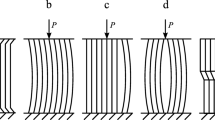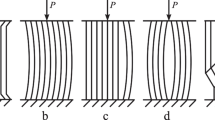Abstract
A detailed finite-element analysis of the stress-strain state in the load transfer zone of uneasily tensioned flat test specimens made of a high-strength unidirectional carbon fiber-epoxy composite is carried out with account of the elastoplastic behavior of a structural polyurethane adhesive. Various schemes of introduction of external loads into the specimens are considered. A numerical finite-element analysis of different configurations of specimen tabs allowed us to put forward a technique for significantly reducing the dangerous concentration of operating stresses.
Similar content being viewed by others
References
M. H. Kural and D. L. Flaggs, “A finite element analysis of composite tension specimens,” Compos. Technol. Rev., 5, No. 1, 11–17 (1983).
M. E. Cunningham, S. V. Schoultz, and J. M. Toth, “Effect of end-tab design on tension specimen stress concentrations,” in: Recent Advances Composite in the United States and Japan, ASTM STP 864 (1985), pp. 253–262.
V. L. Kulakov, Yu. M. Tarnopol’skii, A. K. Arnautov, and J. Rytter, “Stress-strain state in the zone of load transfer in a composite specimen under uniaxial tension,” Mech. Compos. Mater., 40, No. 2, 91–100 (2004).
G. G. Portnov, V. L. Kulakov, and A. K. Arnautov, “A refined stress-strain analysis in the load transfer zone of flat specimens of high-strength unidirectional composites in uniaxial tension. 1. Theoretical analysis, ” Mech. Compos. Mater., 42, No. 6, 547–554 (2006).
C. K. Lapp, “Design allowables substitution. Ch. 33,” in: S. Peters (ed.), Handbook of Composites, Chapman & Hall, London (1998), pp. 758–777.
Yu. M. Tarnopol’skii, I. G. Zhigun, and V. A. Polyakov, Spatially Reinforced Composites, Technomic Publ. Co. Inc., Lancaster, Pa (1992).
MatWeb — On line material data sheet. http://matweb.com
“Test method for tensile properties of polymer matrix composite materials,” in: Annual Book of ASTM Standards. Vol. 15.03, ASTM D3039/D3039M (2003).
Series 647 Hydraulic Wedge Grips. Product Information, MTS System Corp., Eden Prairie (2003).
L. F. M. da Silva and R. D. Adams, “Techniques to reduce the peel stresses in adhesive joints with composites,” Int. J. Adhesion & Adhesives (in press; available on line: http://www.sciencedirect.com).
Author information
Authors and Affiliations
Additional information
__________
Translated from Mekhanika Kompozitnykh Materialov, Vol. 43, No. 1, pp. 43–58, January–February, 2007.
Rights and permissions
About this article
Cite this article
Portnov, G.G., Kulakov, V.L. & Arnautov, A.K. A refined stress-strain analysis in the load transfer zone of flat specimens of high-strength unidirectional composites in uniaxial tension 2. Finite-element parametric analysis. Mech Compos Mater 43, 29–40 (2007). https://doi.org/10.1007/s11029-007-0003-5
Received:
Issue Date:
DOI: https://doi.org/10.1007/s11029-007-0003-5




